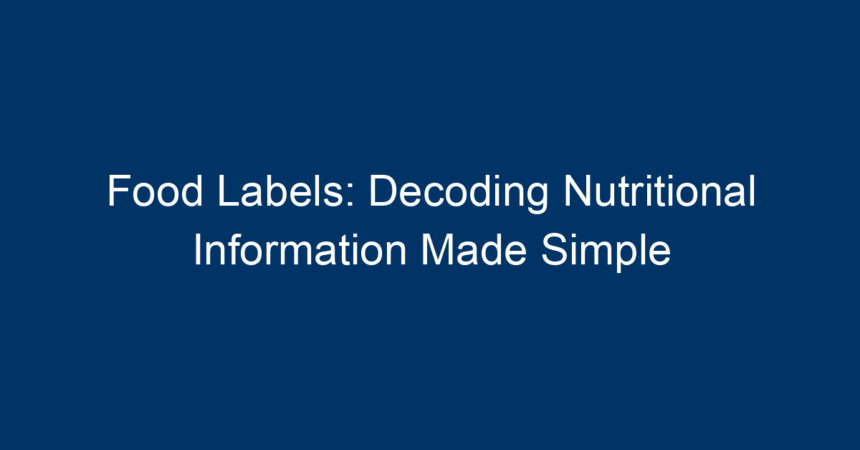Understanding food labels is essential for maintaining a healthy diet. With an array of options available and diverse claims made, knowing how to read food labels can empower consumers to make informed choices. In this article, we will decode nutritional information, breaking it down into simple terms that everyone can understand.
Why Food Labels Matter
Food labels provide crucial information that can help us understand what we’re putting into our bodies. They can guide us in making healthier choices, assist in managing dietary restrictions, and help in weight management. In an age of information overload, food labels serve as a straightforward way to navigate the complexities of nutritional content.
The Basics of Food Labels
Food labels display vital nutritional information mandated by regulatory bodies like the FDA in the United States. Let’s delve into these components to help you navigate your grocery shopping simply and effectively.
1. Serving Size
The serving size provides the baseline for all nutritional values listed on the label. It is crucial to note that a larger container may contain multiple servings. Always check the serving size to gauge how many calories and nutrients you’ll actually consume. Note that servings can be misleading; for example, a small bag of chips may list a serving size as ten chips but is easily consumed in one sitting.
2. Calories
Calories tell you how much energy you’ll get from one serving. Monitoring calorie intake is essential for weight management. If you’re looking to maintain or lose weight, understanding calorie content will help you choose lower-calorie options while still enjoying a variety of foods.
3. Nutrients
The nutrients section typically includes both macronutrients and micronutrients. Here’s what you need to know:
-
Macronutrients: Proteins, fats, and carbohydrates are listed with their respective gram content. Pay attention to the balance of these nutrients in relation to your dietary needs.
- Micronutrients: Vitamins and minerals like vitamin D, calcium, iron, and potassium are often highlighted. Consuming adequate micronutrients is essential for overall health and well-being.
Understanding Percent Daily Values (%DV)
The %DV on food labels indicate how much a nutrient in a serving of food contributes to a daily diet based on a 2,000-calorie daily intake. It helps you gauge whether a product is high or low in a particular nutrient.
- 5% DV or less is considered low.
- 20% DV or more is considered high.
This percentage can be a valuable guide for balancing your nutrient intake across meals.
Deciphering Ingredients Lists
The ingredients list is a key section of food labels. Ingredients are listed in descending order by weight. If the first few ingredients include sugar or fat, the product may not be the healthiest option. Here’s how to analyze the ingredients more effectively:
-
Whole Foods: Look for whole ingredients like "whole grain" or "fresh vegetables." The fewer processed ingredients, the better.
-
Added Sugars: Watch out for added sugars, often disguised under names like fructose, corn syrup, and sucrose. Consuming too much added sugar can lead to various health issues.
- Unrecognizable Ingredients: If the ingredients list resembles a chemistry experiment rather than food, it’s often best to avoid that product.
Common Misconceptions in Food Labels
Despite the information provided on food labels, there are some common misconceptions that can mislead consumers:
-
“Natural” Doesn’t Mean Healthy: Just because a label says "natural" doesn’t mean the product is healthy. Always check the nutritional content.
-
Low-Fat Doesn’t Mean Low-Calorie: Many low-fat products add sugar or other fillers to enhance taste, so they can still be high in calories.
-
Gluten-Free Isn’t Always Healthier: Gluten-free products can still be high in calories, sugar, and fat. Always evaluate them like you would any other product.
- Organic Doesn’t Equal Nutritional Value: While organic products are grown without synthetic fertilizers or pesticides, they can still be high in calories and low in nutritional value.
Navigating Specific Labels
As dietary trends evolve, new labeling terms emerge. Here’s how to decode some of the most common claims you might see:
-
Non-GMO: This label indicates that the ingredients were not genetically modified. While many people seek out non-GMO products for health reasons, research is still ongoing into the impacts of GMOs.
-
Keto-Friendly: Typically, these products are low in carbohydrates and high in fats. Make sure to check if they adhere to your own dietary requirements.
-
Heart-Healthy: Products labeled as heart-healthy often lower in saturated fats and cholesterol. Look for these signals but always double-check the nutritional content.
- Protein-Packed: While high-protein foods can be beneficial, they can also be high in calories and fats. It’s important to consider the overall nutritional profile.
Practical Tips for Using Food Labels
Here are some actionable tips to effectively use food labels to make healthier choices:
-
Plan Your Meals: Preparing your meals in advance makes it easier to choose foods that are lower in calories and higher in nutrients.
-
Compare Products: When faced with choices, use the nutrition information to compare two products directly. This can help you spot the healthier option.
-
Educate Yourself: Take time to educate yourself about what specific nutrients and food groups work best for your health needs.
- Read Beyond the Front: The front of the package may have attractive slogans or designs, but all claims should be verified through the nutritional information on the back.
The Importance of Label Literacy
As consumers, we have the power to make choices that align with our health goals, and it starts with knowing how to read food labels. Being label literate fosters better dietary habits, aids in the prevention of chronic diseases, and encourages a more balanced lifestyle.
Conclusion: Empower Yourself with Knowledge
Decoding food labels doesn’t have to be overwhelming. With a little practice and awareness, you can easily navigate nutritional information and make healthier choices when shopping for food. Keep your dietary goals in mind, watch out for misleading claims, and prioritize whole foods for the best results.
The next time you’re in a grocery store, take a moment to study the food labels of your choices. Not only will you understand what you’re consuming, but you’ll also empower yourself to take charge of your health, one label at a time.




